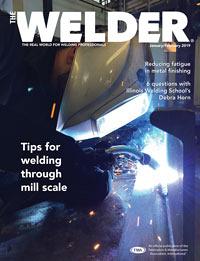Independent welding consumables professional
- FMA
- The Fabricator
- FABTECH
- Canadian Metalworking
Categories
- Additive Manufacturing
- Aluminum Welding
- Arc Welding
- Assembly and Joining
- Automation and Robotics
- Bending and Forming
- Consumables
- Cutting and Weld Prep
- Electric Vehicles
- En Español
- Finishing
- Hydroforming
- Laser Cutting
- Laser Welding
- Machining
- Manufacturing Software
- Materials Handling
- Metals/Materials
- Oxyfuel Cutting
- Plasma Cutting
- Power Tools
- Punching and Other Holemaking
- Roll Forming
- Safety
- Sawing
- Shearing
- Shop Management
- Testing and Measuring
- Tube and Pipe Fabrication
- Tube and Pipe Production
- Waterjet Cutting
Industry Directory
Webcasts
Podcasts
FAB 40
Advertise
Subscribe
Account Login
Search
Consumables Corner: Solving weld crack issues with 4150 chrome-moly steel
- By Nino Mascalco, Rob Koltz, and Steve Sigler
- January 26, 2019
- Article
- Arc Welding
Q: We currently manufacture a product that comprises a 4150 steel pipe that is 30 in. in diameter and 2 in. thick, welded to a 1018 steel plate that is 3 in. thick. The pipe has a 3/8-in. bevel and we join it using a triple-pass weld. Recently we switched from an ER80 filler metal containing 1 percent nickel to an ER70S-6 filler metal. We are now experiencing weld cracking that runs adjacent to the toes of the weld on the 4150 side, and sometimes in the weld metal. We use a preheat of 400 degrees F. Do you have any suggestions on how we can eliminate the cracking?
A: This problem is not at all uncommon when welding on chromium-molybdenum (CrMo) or high-strength, low-alloy steels. First you must understand the material properties.
The AISI/SAE 1018 steel fits into the low-carbon (0.05 to 0.3 percent carbon) grade and has a carbon range of 0.14 to 0.2 percent. It has a minimum yield strength (YS) of 53,700 PSI and an ultimate tensile strength (UTS) of 63,800 PSI. Since the carbon content is relatively low, and there are no other significant alloying elements that could drastically increase the carbon equivalency, there isn't much else to consider during welding. Although, due to the thickness of your application, we do recommend some weld preheat.
AISI/SAE 4150 is considered a 41XX series CrMo alloyed steel. Various grades have slightly different alloying compositions and are identified by the last two numbers of the SAE designator, which represents the carbon content. It is also considered a medium-carbon (0.3 to 0.8 percent carbon) steel grade with 0.48 to 0.53 percent carbon, hence the “50” in the name. The mechanical properties are greater compared to the 1018 steel. The 4150 steel has a minimum YS of 55,100 PSI and a UTS of 106,000 PSI in the annealed condition. Because of the elevated carbon content with the addition of alloys and a calculated carbon equivalency of approximately 0.88, preheating before any welding takes place is required along with considerations after welding.
Regarding your application, three things make it more challenging. First, the considerable material thickness equates to fast cooling rates. Second, a high-strength alloyed steel typically has a microstructure that is susceptible to martensite formation and potentially hydrogen-induced cracking. Third, a pipe-to-plate weld structure is considered to be a high-restrained weld joint configuration.
You stated that you were previously using an ER80 product that contained 1 percent nickel and never experienced cracking. Depending on weld parameters, heat input, and weld size, the nickel content may be responsible for the resistance to postweld cracking. Changing to the ER70S-6 electrode shouldn't have caused any issues since the 1018 plate is the governing material for filler metal matching considerations. Remember, the general rule is to match to the lower-strength material.
A few variables are missing that could help us analyze the issue, such as your base material condition (i.e., annealed or normalized), shielding gas type, welding electrode type or process, weld bead size, technique, and all related weld parameters. Additionally, what postweld procedure did you follow?
With the high carbon equivalency of the 4150 material and the 2 in. thickness, we recommend you apply a minimum preheat of 600 degrees F before any welding activities, including tack welding.Oftentimes people skip preheat before tack welding and fit-up. Tack welding is still considered welding, and with the extreme temperature of the welding arc and cool base material, the tack weld cools incredibly fast along with the heat-affected zone (HAZ), resulting in small cracks in the susceptible material. Once a crack has formed, there is nothing to stop it from propagating and causing a failure.
Before fit-up, apply a uniform and thorough soaking preheat. Tack weld the components into place while maintaining the minimum preheat. Weld the joint completely before cooling is allowed, using weld beads equivalent to a ¼- to 5/16-in. fillet. Make sure the welds are continuous around the pipe if possible, or weld opposing sections to balance the weld shrinkage stresses.
For example, if you weld a section from the 12 o’clock to the 3 o'clock positions, you should weld the next section from the 6 o’clock to the 9 o'clock positions, and so on. After full-weld, maintain the minimum preheat temperature for one hour per inch of thickness (two hours in your case) to allow any potential hydrogen to diffuse out of the material. Afterwards, remove the preheat source and thoroughly cover the weld with proper insulating materials, such as several layers of fire blankets or ceramic insulation.
About the Authors


Rob Koltz
Application Engineer
411 S. Ebenezer Rd.
Florence, 29501
636-485-2253
Steve Sigler
Application Engineer
411 S. Ebenezer Rd.
Florence, South Carolina 29501
636-485-2253
About the Publication
subscribe now

The Welder, formerly known as Practical Welding Today, is a showcase of the real people who make the products we use and work with every day. This magazine has served the welding community in North America well for more than 20 years.
start your free subscription- Stay connected from anywhere

Easily access valuable industry resources now with full access to the digital edition of The Fabricator.

Easily access valuable industry resources now with full access to the digital edition of The Welder.

Easily access valuable industry resources now with full access to the digital edition of The Tube and Pipe Journal.
- Podcasting
- Podcast:
- The Fabricator Podcast
- Published:
- 04/16/2024
- Running Time:
- 63:29
In this episode of The Fabricator Podcast, Caleb Chamberlain, co-founder and CEO of OSH Cut, discusses his company’s...
- Industry Events
16th Annual Safety Conference
- April 30 - May 1, 2024
- Elgin,
Pipe and Tube Conference
- May 21 - 22, 2024
- Omaha, NE
World-Class Roll Forming Workshop
- June 5 - 6, 2024
- Louisville, KY
Advanced Laser Application Workshop
- June 25 - 27, 2024
- Novi, MI
































